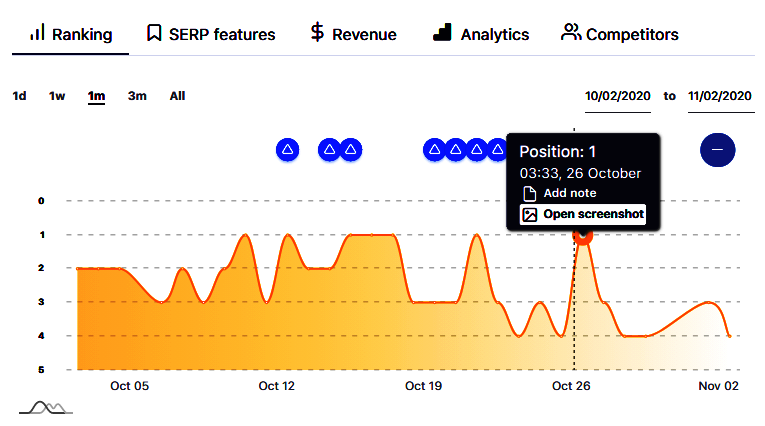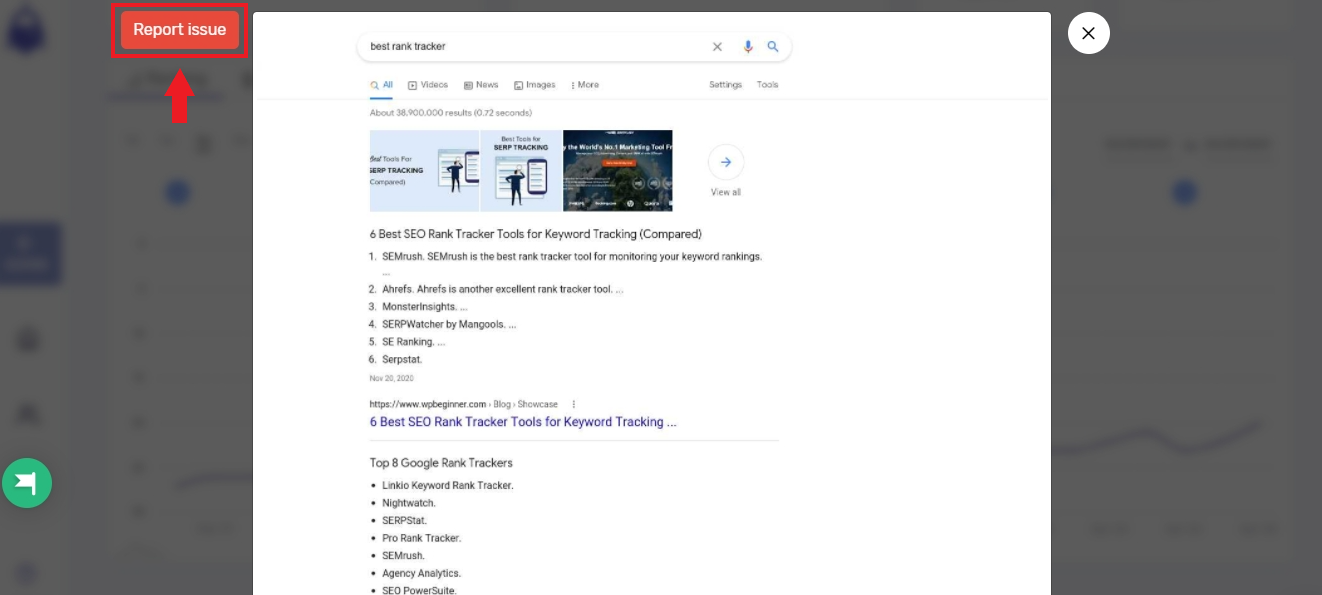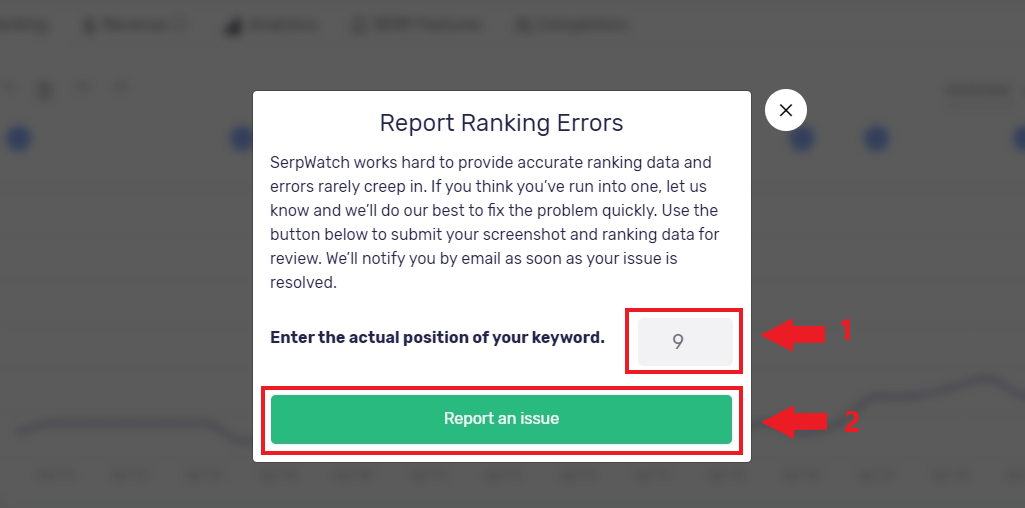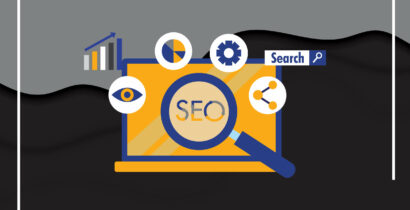
SerpWatch Rank Tracker: The Secrets of Data Accuracy

Have you ever stopped to think how accurate your rank tracker really is?
Let’s first make something clear: no rank tracker is perfect. If somebody guarantees 100% accurate data, they are wrongly assuming that search engines never change.
But that’s not to say all rank trackers are created equal.
Ranking data errors can happen with any tool – and we’ll discuss why this is so later on. However, few tools take accuracy as seriously as SerpWatch.

SerpWatch designed its very own high-accuracy system that minimizes and accounts for rank tracking errors.
Say, for example, that a rank tracker shows your rankings have suddenly dropped dramatically. You would normally want to address the issue as soon as possible. But a knee-jerk reaction is the last thing you need.
Because what if the app is lagging and your position hasn’t actually changed?
So before we dive deeper into the details of SerpWatch’s near-perfect accuracy, let’s discuss why rank errors happen in the first place.
Why is My Rank Tracker Showing Different Data than Google?
To assess how accurate a rank tracker is, we first need to define what “accurate data” means in this context.
When we’re talking about the ever-evolving search engine results pages (SERPs), “accurate” can mean many different things.
Once upon a time, SERPs for the same query had a uniform look – regardless of who was performing the search.
But we’ve come a long way since then. Google is now constantly updating SERPs and adapting it to the individual preferences of the searcher.
This is because Google’s primary aim is to serve results that are as relevant as possible to the user.
For this reason, search results pages now commonly contain non-traditional elements – known as SERP features – that display search results in formats other than the traditional blue links.
The most common SERP features include Images, Videos, Featured Snippets, Reviews, Knowledge Graphs, People Also Ask, and Answer Boxes.

What features appear on the SERP depends on a number of factors.
Ultimately, it comes down to one thing – personalization.
Personalized Results
Personalized results are based on more than query strings and tailor-made to match individual users’ needs.
Owing to its machine-learning AI system RankBrain, Google can understand the concepts behind words users type in search.
Google will look at keywords used in search and interpret them in relation to other words.
This is very similar to the way humans process natural language.
Words don’t exist in a vacuum and interpretation almost always requires context.
This is why Google will take your query and try to understand how individual words are semantically related.
But that’s not all.
Google will also take into account everything it knows about the user performing the search.
For instance, if you and I both search for “coffee shop”, Google will show us two different SERPs.

What we see on the SERPs will depend on many variables.
These variables include location, language preferences, device, search history, browser settings, etc.
Google’s RankBrain can also gauge how satisfied you were with the pages you visited in the past.
If the RankBrain “rates” your satisfaction with a page as high, it will serve that page higher up on the SERP next time around.
However, if it sees that you left the page quickly without engaging with the content, it will show a different page in its place.
The bottom line is that Google wants to cater to each individual user in the best way possible. And this is why search results are highly personalized.
SEO Implications
While personalization of search results contributes to a richer user experience, it also makes SEO’s job difficult.
SERPs can widely differ in appearance depending on who is performing the search. And this is why you will never be able to manually check your keyword ranking. You need a highly accurate rank tracker tool for the job.
You would have to go to great lengths to get an objective view of how just one keyword is ranking in Google, let alone hundreds or thousands.
As already mentioned, some of the factors Google takes into account when displaying SERPs are user’s search history and level of engagement with previously visited pages.
Since you’ve probably visited your own site more often than anyone else, the rankings you see in the SERPs will always be skewed in your favor.
If you’re a website owner or an SEO targeting customers in multiple locations, checking your rankings manually will tell you little about how people in different cities or countries see your website on the SERPs.
While Google has previously denied that the discrepancies between how different people see the SERPs are the result of unbridled personalization, multiple case studies say otherwise.

According to one such study from DuckDuckGo, “most people see results unique to them, even when logged out and in private browsing mode.”
But whether you choose to believe Google when it says it doesn’t “personalize search results based on demographic profiles” or studies that point in the opposite direction, one thing’s for sure – SERPs look different to different people and all SEOs should take this into account when deciding who to trust with tracking their rankings.
What Makes SerpWatch a Highly Accurate Rank Tracker?
SerpWatch takes data accuracy extremely seriously.
While SerpWatch boasts a long list of rank tracking features that tick almost every SEO box, it is data accuracy that makes SerpWatch stand out among competitors.

In order to push your SEO strategy in the right direction, you want to be able to verify that the tool is showing rank tracking data that matches what your customers see in search results.
Theoretically speaking, you could regularly check your rankings manually to make sure all is well but if you had that kind of time on your hands, you wouldn’t need an accurate rank tracking tool in the first place.
Due to Google’s unpredictable algorithms, a margin for error always exists. This is why SerpWatch has a unique system in place to ensure the data shown to our clients is as accurate and reliable as possible.
Besides up-to-date SERP screenshots, SerpWatch also supports targeted rank tracking for different locations and a unique image verification function that acts as a defense mechanism against engine failures.
SERP Screenshots & Reporting Rank Errors
Since trust and transparency are top priorities at SerpWatch, users can verify their ranking data at any time with SERP screenshots accessible directly from the ranking graph.
As Google continues to update its search algorithm and UI on a near-daily basis, so does SerpWatch team continue to work on keeping all rank data up to date.
SerpWatch allows you to verify data with SERP screenshots for the last 10 days of your rankings – and if you see any discrepancies, you can always contact support and the tech team will fix the issue ASAP.
How to Report a Rank Issue
To report a ranking error, open the SERP screenshot from the Keyword view and click the “Report issue” button.

Next, enter the actual position of your keyword and click “Report an issue”.

As soon as you report the issue, SerpWatch team will receive a notification in Slack. The tech team will then investigate the issue and in case they confirm the discrepancy, they will email you with a plan of action.

Location Verification
Local search intent is one of the many factors that can affect the appearance of SERPs.
While you could manually verify your keyword rankings by performing the same search from different physical locations, again this is something a rank tracker should do for you.
SerpWatch shows your keyword rankings based on the precise geo-location enabled by the UULE parameter.
When the UULE parameter is added to the URL of a SERP, it reproduces search results for the specified geolocation.
This is especially useful if your target location differs from your actual physical one or if you’re an SEO who runs campaigns for multiple clients in different locations.
And if you want to verify that SerpWatch is showing the accurate location for your ranking data, simply open the SERP screenshot from the ranking chart and scroll down to the bottom of the page.

Image Recognition
Seeing different ranking positions in the tool than what the actual SERPs show is a problem many rank tracker users face.
For example, a rank tracker may suddenly show that your keyword is no longer found in the Top 100, but when you open the SERP you realize that your ranking position hasn’t actually changed.
To bypass this issue, SerpWatch has developed a unique image recognition function that prevents these drastic discrepancies from showing up in your ranking chart.
Here’s how it works:
- The app sends ranking data for verification to our engine
- The engine opens Google and enters the data it received from the app
- A screenshot is taken
- The engine parses data from the SERP
- If the engine doesn’t recognize the data, it sends it to the API endpoint for re-verification based on the screenshot the engine took
- The engine analyzes the text from the screenshot with the help of an optical character recognition software
- The software then passes the text onto the API for further processing
- The API looks for your specified domain in the text and returns the results to you
- If your domain is found in the text, then a failure message is sent to Slack and the data is re-checked
- If, however, the domain is not found, it means the ranking data shown in the chart matches the SERP results.
The Bottom Line
If all of this sounds complicated, it’s only because SerpWatch doesn’t take data accuracy lightly.
As Google continues to alter its search algorithm, keyword rank tracking gets trickier by the day. And since SEOs already have their hands full with managing complex campaigns, the last thing they need to worry about is whether their rank tracker is showing accurate data.
Of course, there’s no such thing as a 100% accurate rank tracker. But SerpWatch is the only rank tracker with a data tracking system that adapts to the ever-changing SERP landscape.
SerpWatch reduces rank errors to a minimum with the help of SERP screenshots, location verification, and image recognition.
But don’t take my word for it – try it out yourself!






There are currently no comments.
Be the first!))